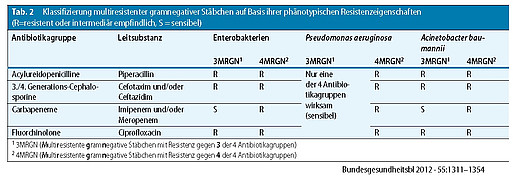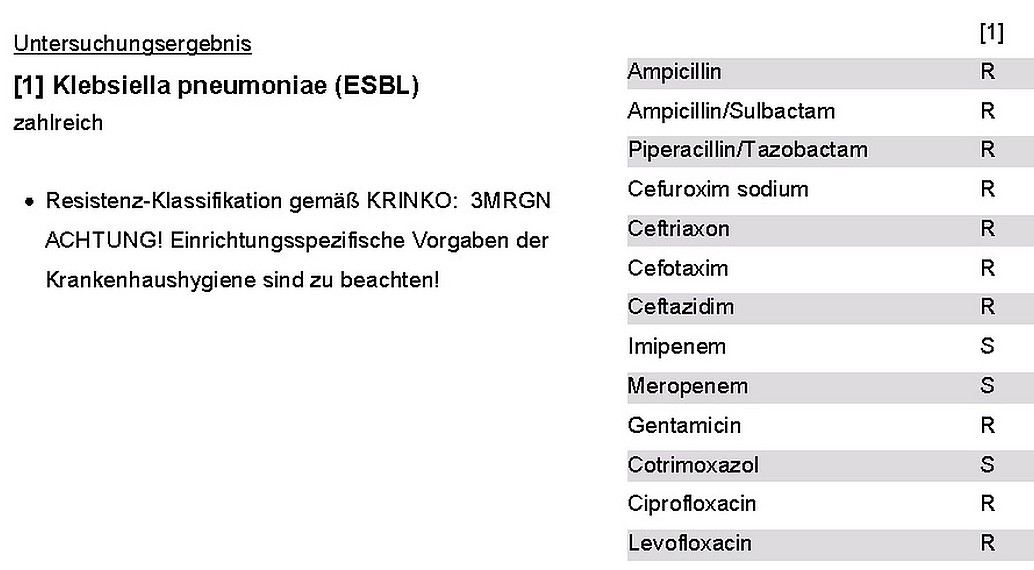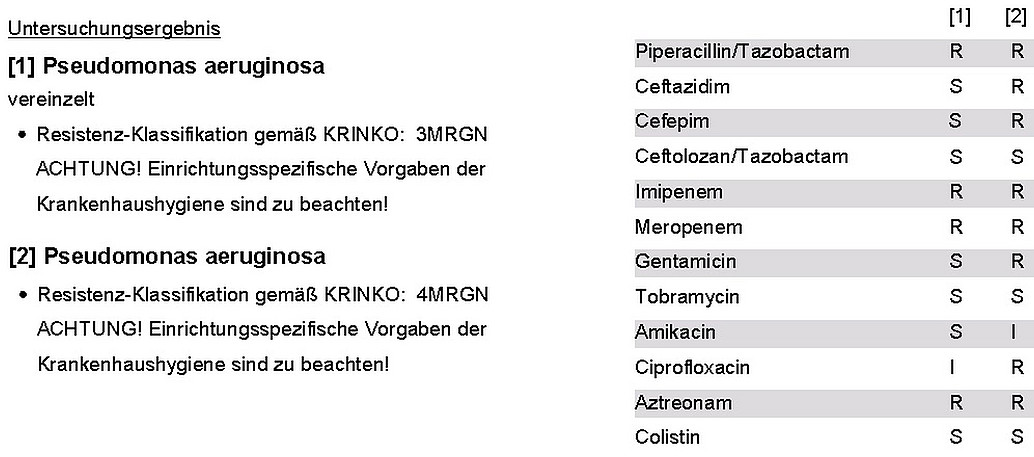Useful information about the MRGN classification
Explanations on the MRGN classification
In order to pragmatically define "multi-resistance" in hospital-hygienically relevant gram-negative rod bacteria, a new classification was introduced in Germany in 2012: Multi-resistant gram-negative bacteria are defined in the MRGN classification depending on their sensitivity to 4 different antibiotic groups. The classification of corresponding isolates is noted behind the respective species of bacteria: e.g. Pseudomonas aeruginosa 3MRGNThe original publication, which contains the initial MRGN definition, was published in October 2012 by the Commission for Hospital Hygiene and Infection Prevention (KRINKO) at the Robert Koch Institute (RKI):
Hygiene strategies in case of infection or colonisation with multi-resistant gram-negative rods
The document contains the initial, simple MRGN definition:
- depending on the sensitivity to 4 defined groups of antibiotics
- for particular gram-negative rod bacteria whose resistance characteristics are of relevance to hospital hygiene
- not all (resistant) gram-negative bacteria are subject to the MRGN classification:
Only the bacteria or groups of bacteria mentioned below are addressed.
The following types of "gram-negative rods" are affected:
For the following representatives, additional hospital hygienic protective measures are indicated for 3MRGN and always for 4MRGN variants:
For the following representatives, additional hospital hygienic protective measures are indicated for 3MRGN and always for 4MRGN variants:
- Escherichia coli and Klebsiella spp.
- Pseudomonas aeruginosa
- Acinetobacter baumannii complex
For the following representatives, additional hospital hygiene protection measures are only indicated for 4MRGN variants:
1) Piperacillin (-Tazobactam [Tazobac®])
2) Third generation cephalosporins
- for enterobacteria: Cefotaxime/Ceftriaxone
[e.g. Claforan®, Rocephin®]
- for P. aeruginosa: Ceftazidim/ Cefepim
[e.g. Fortum®, Maxipime®]
3) Fluoroquinolone: Ciprofloxacin [Ciprobay®].
4) Carbapenems: Imipenem/ Meropenem [e.g. Zienam®, Meronem®].
In principle, the following applies: If a bacterium of the species listed in the above table is "no longer sensitive" to three of the four antibiotic groups, i.e. intermediate (I) or resistant (R), the bacterium is given the suffix "3MRGN"; if, on the other hand, it is no longer sensitive to all four antibiotic groups, the bacterium is given the suffix "4MRGN".
The condition "no longer sensitive" is fulfilled if the phenotypic test is intermediate (I) or resistant (R) to one of the possible substances within an antibiotic class. However, in the case of Pseudomonas aeruginosa, the condition "no longer sensitive" is exceptionally only fulfilled if all substances within an antibiotic class have been tested as intermediate (I) or resistant (R) and thus as "non-sensitive".
Tool for concrete MRGN classification (NRZ Bochum)
- other enterobacteria (e.g. Serratia spp., Proteus spp., Enterobacter spp. etc.)
1) Piperacillin (-Tazobactam [Tazobac®])
2) Third generation cephalosporins
- for enterobacteria: Cefotaxime/Ceftriaxone
[e.g. Claforan®, Rocephin®]
- for P. aeruginosa: Ceftazidim/ Cefepim
[e.g. Fortum®, Maxipime®]
3) Fluoroquinolone: Ciprofloxacin [Ciprobay®].
4) Carbapenems: Imipenem/ Meropenem [e.g. Zienam®, Meronem®].
In principle, the following applies: If a bacterium of the species listed in the above table is "no longer sensitive" to three of the four antibiotic groups, i.e. intermediate (I) or resistant (R), the bacterium is given the suffix "3MRGN"; if, on the other hand, it is no longer sensitive to all four antibiotic groups, the bacterium is given the suffix "4MRGN".
The condition "no longer sensitive" is fulfilled if the phenotypic test is intermediate (I) or resistant (R) to one of the possible substances within an antibiotic class. However, in the case of Pseudomonas aeruginosa, the condition "no longer sensitive" is exceptionally only fulfilled if all substances within an antibiotic class have been tested as intermediate (I) or resistant (R) and thus as "non-sensitive".
Tool for concrete MRGN classification (NRZ Bochum)
Temporary modifications in the interpretation of resistance are implemented in a tool on the website of the National Reference Centre for Gram-negative Hospital Pathogens in Bochum; this tool allows the correct assignment within the MRGN classification after entering bacterial species and a concrete antibiogram.
Image for MRGN classification
Image for MRGN classification
Illustration of MRGN classification

The KRINKO publication also includes recommendations describing how to deal with MRGN in so-called "risk areas" outside the MRGN in acute care hospitals. (Corresponding risk areas have been defined at the University Medical Centre Mainz; these can be requested via the hospital hygiene). For hospital hygiene measures it is irrelevant whether an MRGN finding is to be understood as an expression of colonisation or infection.
While "4MRGN" is always labelled, on our microbiological findings a labeling as "3MRGN" is only given for the germ detections that belong to the above mentioned groups of bacteria.
Escherichia coli, Klebsiella spp., Pseudomonas aeruginosa or Acinetobacter baumannii complex
This is to avoid that non-indicated measures are derived from a corresponding "3MRGN" finding.
Special condition within the first year of life:
Exclusively for this group of patients a further designation is planned: "2MRGNNeoPäd", which is used analogously to the above description if already 2 of the 4 antibiotic groups are no longer sensitive. In this age group, the above species-based restriction to "3MRGN" does not apply (if the bacterium is basically part of the MRGN classification).
Any necessary hospital hygiene measures can be found in the respective hygiene plans.
If you have difficulties with the interpretation of a finding, please contact us.
- Basic hygiene measures are always indicated without exception.
- Every finding of a "4MRGN" indicates additional hospital hygiene measures.
- "3MRGN" is not always "3MRGN". Only within the defined risk areas it is necessary to react to "3MRGN" with additional protective measures if it is a representative of the following species of bacteria: Escherichia coli, Klebsiella spp., Pseudomonas aeruginosa or Acinetobacter baumannii complex
While "4MRGN" is always labelled, on our microbiological findings a labeling as "3MRGN" is only given for the germ detections that belong to the above mentioned groups of bacteria.
Escherichia coli, Klebsiella spp., Pseudomonas aeruginosa or Acinetobacter baumannii complex
This is to avoid that non-indicated measures are derived from a corresponding "3MRGN" finding.
Special condition within the first year of life:
Exclusively for this group of patients a further designation is planned: "2MRGNNeoPäd", which is used analogously to the above description if already 2 of the 4 antibiotic groups are no longer sensitive. In this age group, the above species-based restriction to "3MRGN" does not apply (if the bacterium is basically part of the MRGN classification).
Any necessary hospital hygiene measures can be found in the respective hygiene plans.
If you have difficulties with the interpretation of a finding, please contact us.
Examples of findings

